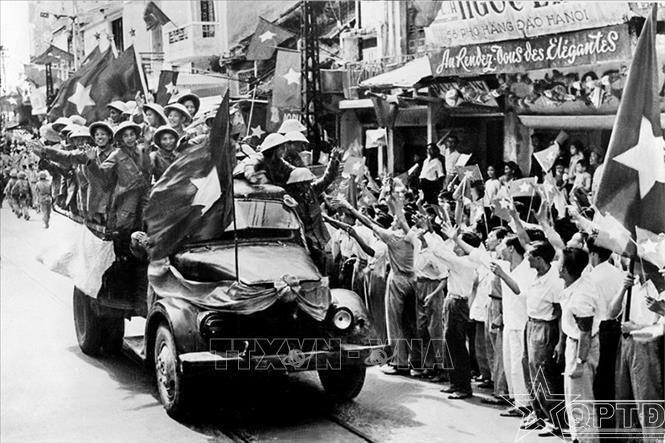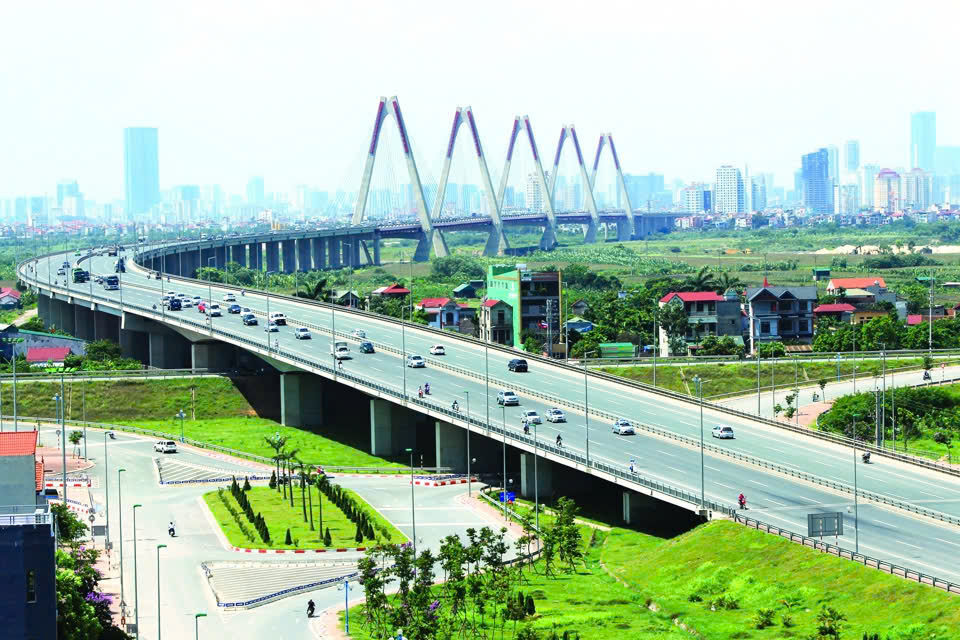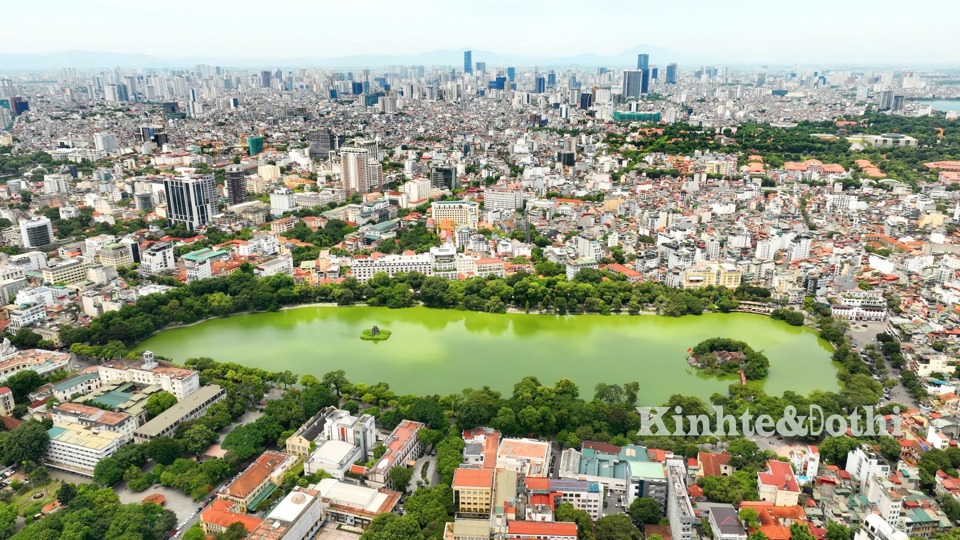
The liberation of the capital marked a pivotal moment, affirming the nation’s victory over French colonial forces and opening a new chapter in the thousand-year history of Thang Long-Hanoi.
On October 10, 1954, Hanoi residents joyfully welcomed the victorious troops, marking the end of the heroic resistance against French colonialism. Seventy years on, Hanoi continues to honor past sacrifices, achieving remarkable progress in economic and social development.

On the morning of October 10, 1954, the 308th Division's troops entered the liberated capital through the city gates, greeted by a sea of flags and flowers from 200,000 Hanoi residents.
According to historical documents, since the proclamation of the "Edict on the Transfer of the Capital" by King Ly Thai To in 1010, Thang Long-Hanoi has witnessed countless transformations throughout history. The soldiers and people of Hanoi, generation after generation, have worked tirelessly, courageously fought, and creatively built a radiant cultural legacy.
In its proud history, Thang Long-Hanoi has endured more than 10 wars of resistance against foreign invaders, all of which ended in victory. Among these, the Capital Liberation Day on October 10, 1954, stands as a shining milestone. This event not only marked the triumph of a small nation against one of the world's leading colonial powers but also ushered in a new era under the leadership of Ho Chi Minh in the development of Thang Long-Hanoi.
Historical records show that following the signing of the Geneva Accords, French forces were forced to withdraw from Hanoi. Troops from the Viet Bac War Zone and the battlefields of the northern plains marched toward the capital to take control. On the morning of October 10, 1954, the city’s Military Administrative Committee and various military units—infantry, artillery, air defense, and mechanized divisions—advanced into Hanoi in a historic march.
At 3 p.m. that day, following a long siren blast at the Opera House, hundreds of thousands of Hanoi’s residents and armed forces attended the national flag-raising ceremony held at the Flag Tower Stadium. After the ceremony, Chairman of the Military Administrative Committee Vuong Thua Vu read President Ho Chi Minh's call to the people of the capital on this momentous day.
The handover of the capital was completed swiftly and smoothly. A total of 129 offices, public buildings, factories, hospitals, and schools, including key military and administrative sites, were handed over safely. The daily lives of the people remained stable, with uninterrupted services in electricity, water, and communication. Public security, political stability, and social order were well-maintained, while schools, hospitals, cultural institutions, and newspapers continued their operations under the new administration.
The liberation of the capital marked a significant turning point, affirming the complete victory of the country’s military and people in the war of resistance against the French colonizers. It also opened a new chapter in the millennia-old history of Thang Long-Hanoi.

Nhat Tan Bridge.
Hanoi maintains strong growth over the years
After the handover, the Party and government of Hanoi quickly stabilized the situation, and within a year, the city had successfully completed land reforms—a key revolutionary task of the national democratic movement.
During the resistance against the United States, tens of thousands of Hanoians joined the military to fight on various fronts. At home, Hanoi became a major economic center of North Vietnam, providing supplies to the front lines under the motto "not a grain of rice, not a soldier short."
Most notably, Hanoi, along with other localities under the leadership of the Party, achieved a great victory during the “Dien Bien Phu in the Air” campaign in December 1972. This forced the US to return to the negotiating table and sign the Paris Peace Accords, ending the war and restoring peace in Vietnam on January 27, 1973. This laid the groundwork for the eventual Great Spring Victory in 1975, leading to national reunification.
With the country unified, Hanoi transformed into a vast construction site, building and developing its economy, culture, and society while improving the lives of its people. The Party Committee of Hanoi creatively implemented economic reforms, developing a multi-sector economy operating under a market mechanism with state regulation aligned with socialist principles.
A major milestone came with National Assembly Resolution 15/2008/QH12, which officially expanded Hanoi's administrative boundaries on August 1, 2008. This expansion marked a significant change, creating new opportunities and a fresh outlook for the capital.
Over the past 16 years, Hanoi has continued to lead in many areas, achieving outstanding accomplishments and significantly contributing to the nation’s development. Hanoi has maintained steady growth, consistently contributing to the country’s economy. For example, in the first half of 2024, the capital's gross regional domestic product (GRDP) increased by 6.0%, budget revenue reached 61.7% of the annual target (up 12.5% year-on-year), exports rose by 8.8%, and investment capital grew by 9.55%.

Hanoi from above.
Notably, Hanoi has achieved great success in its new rural development program. To date, all 18 districts and towns (100%) have met new rural standards, as have all 382 communes. Additionally, 186 communes have achieved advanced rural standards, and 68 communes have reached exemplary new rural standards.
In parallel, Hanoi has focused on both economic and cultural development. The city has undertaken a major initiative to preserve and restore over 5,000 historical sites. Its education system is also leading the nation. In terms of infrastructure, Hanoi has begun the construction of the Ring Road 4 – Capital Region project to enhance connectivity with other provinces and cities.
On June 28, 2024, the National Assembly passed the Amended Capital Law, which will take effect on January 1, 2025. The Assembly also reviewed two major planning projects: the general construction plan for Hanoi to 2030 with a vision to 2050, and the adjusted plan for the capital’s development to 2045 with a vision to 2065. These plans aim to shape the future of urban space, management, investment, and development in Hanoi.
As part of its urbanization efforts, Hanoi is making bold strides in city development, mobilizing diverse social resources. New, modern urban areas are being built, creating expanded and modernized urban spaces.
Hanoi is also investing in upgrading several districts, including Dong Anh, Gia Lam, Thanh Tri, Hoai Duc, and Dan Phuong, to become urban districts. The city is expanding its northern urban area and synchronizing infrastructure to gradually build a smart city in the near future. In the coming years, Hanoi will focus on implementing its development plans for the 2021-2030 period, with a vision to 2050, after these plans are approved.
With these concrete, focused solutions and the unity of its political system and citizens, Hanoi is poised for a new breakthrough, laying the foundation for achieving its political, economic, and social goals in the years to come. This will contribute to building a prosperous and civilized Hanoi, worthy of its status as the heart of the nation.
Ngoc Mai